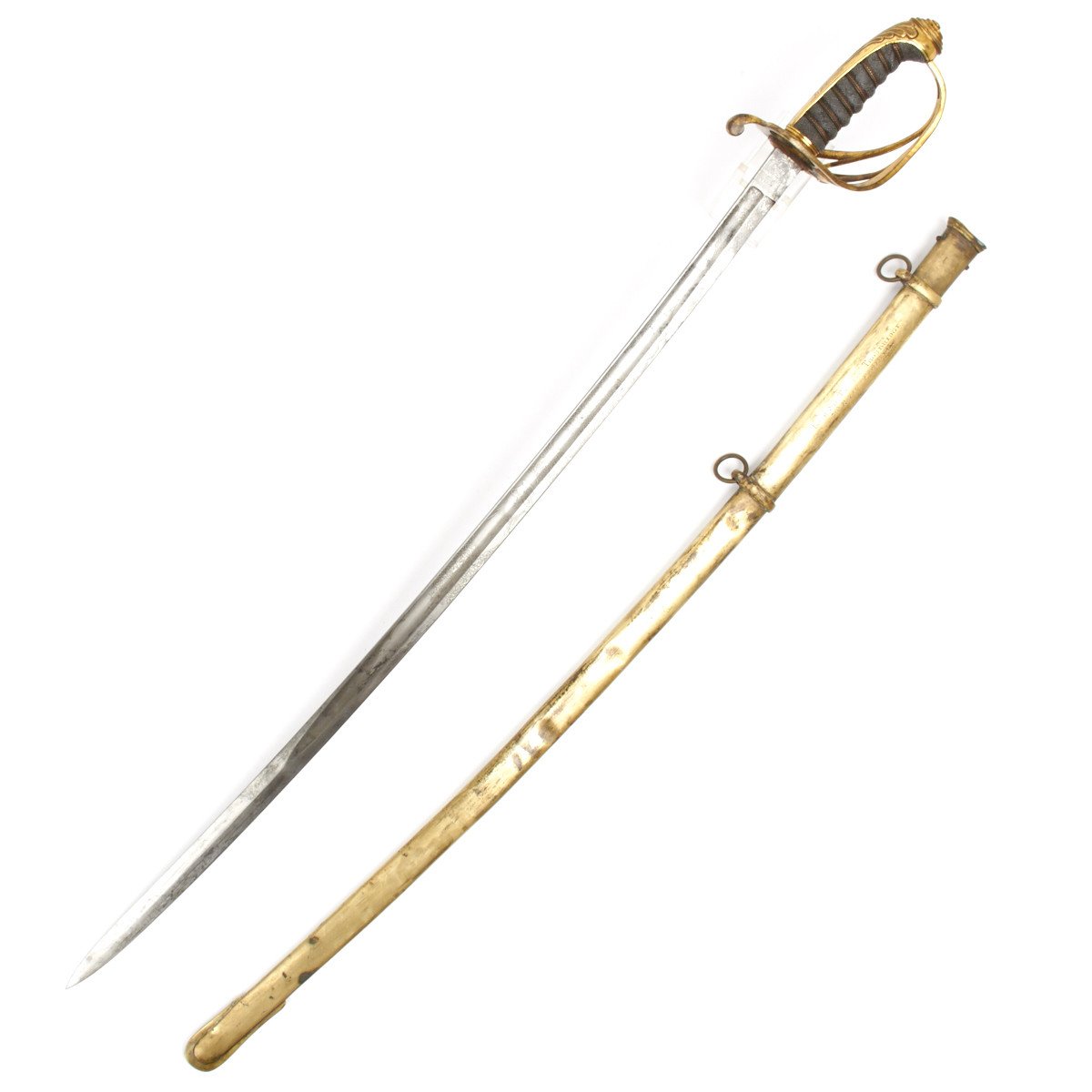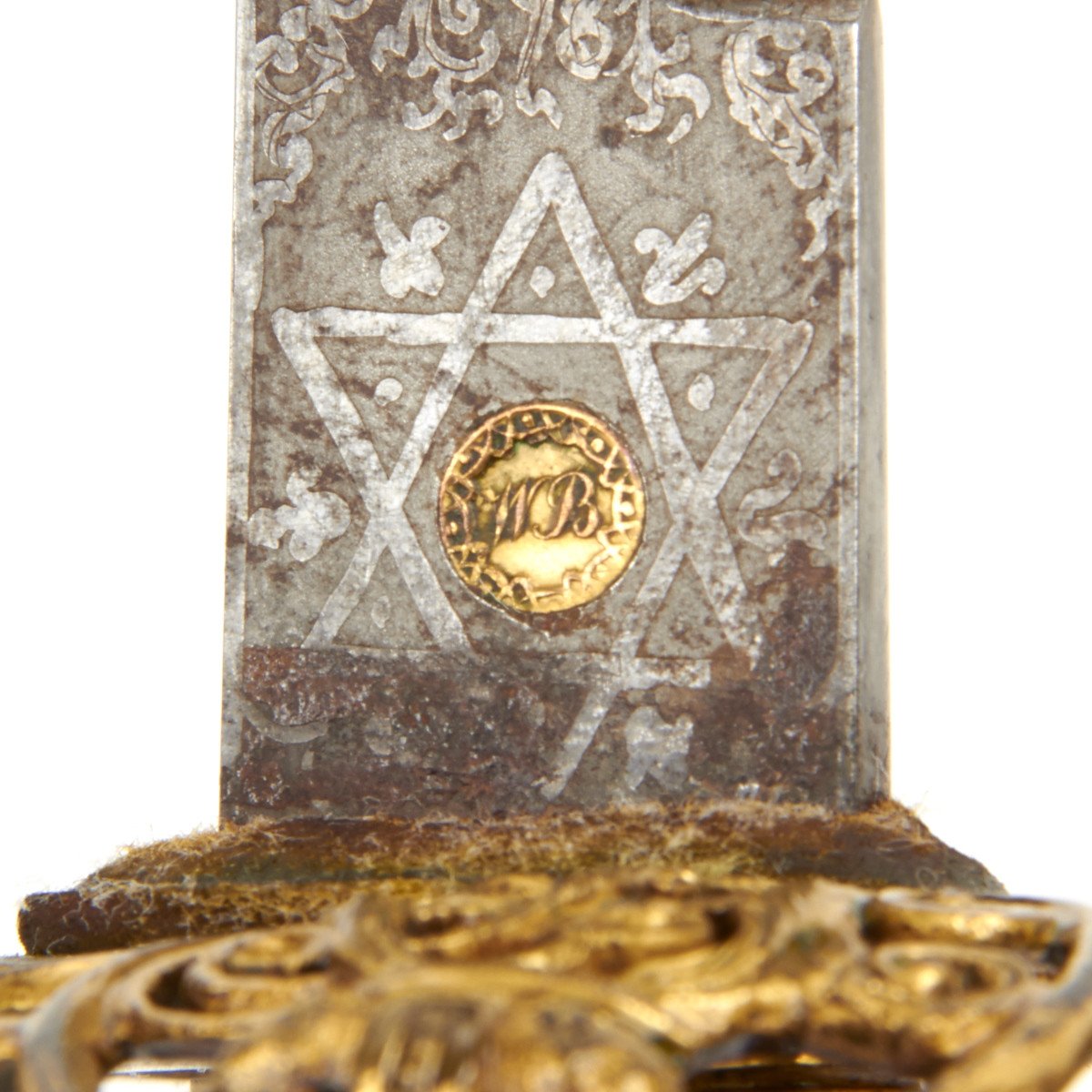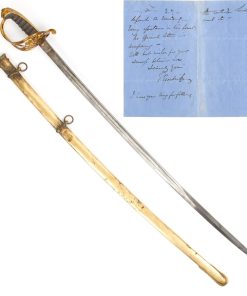Original British Crimean War Officer Sword with Letter of Sir Thomas Troubridge of the 7th Royal Fussiliers Original Items
$ 1.495,00 $ 373,75
Original Items: One-of-a-kind set. This set originates from a fifty year old British Collection of named pieces with associated signed or significant documents that add to the provenance of each piece.
The sword is a typical overseas service officer’s sword of the early Victorian era having a gold washed hilt and guard with a Crowned V.R. Cypher incorporated into the hand guard. The grip is brass wire wrapped sharkskin. The slightly curved blade is beautifully engraved and bears the Royal Cypher of a crown over V.R. along with the maker’s name:
BUKMASTER
-3-
NEW BULINGTON
-ST-
LONDON
The scabbard is a tropical service all brass construction and is finely engraved:
MAJOR SIR THOMAS TROUBRIDGE
7TH ROYAL FUSILIERS
Included with the sword is a hand written letter signed by T. Troubridge dated 1858 from “Horseguards”, his regimental headquarters in London. The letter is addressed to General Hay at Hythe concerning the lubrication of cartridges.
Sir Thomas St Vincent Hope Cochrane Troubridge, 3rd Baronet CB (25 May 1815 2 October 1867) was an officer of the British Army who served with distinction during the Crimean War.
Born into a distinguished family with strong military connections, two grandfathers and his father had been admirals in the Royal Navy, Troubridge entered the army and rose through the ranks, serving at first with the 73rd (Perthshire) Regiment of Foot, and then the 7th (Royal Fusiliers) Regiment of Foot, the latter being a regiment he would later command. He served with his regiment in many stations throughout the Empire, inheriting his father’s baronetcy in 1852, and held the rank of major in 1854 when the Crimean War broke out. Troubridge went out with his regiment and saw action in some of the early battles of the war, playing an important role in the Battle of Alma. He was involved in the heavy fighting surrounding the defence of British gun batteries during the Battle of Inkerman, and was badly wounded, losing his right leg and left foot. He refused to leave the battlefield until the attacks had been repulsed, and was commended for his gallantry by his commanding officer.
He returned to Britain and received a number of awards and promotions for his actions in the Crimea, but was unable to return to front-line service due to his injuries. He remained active in the army in superintending parts of the supply and logistics forces, which he carried out until his death in 1867.
Crimean War
Depiction of some of the heavy fighting during the Battle of Inkerman, by David Rowlands
With the outbreak of the Crimean War in 1854, Troubridge was sent with his regiment to the Crimea, and was involved in several of the early battles, seeing action at the Battle of Alma, the operations around the Siege of Sevastopol, and the Battle of Inkerman. At Alma he commanded the Royal Fusiliers’ right wing, on the right of the Light Division under Sir George Brown. During the battle Troubridge and the Royal Fusiliers engaged the left wing of the Kazan regiment, and Troubridge led his forces under heavy fire on an assault on the fortified heights. He remained with the Royal Fusiliers during their operations in support of the allied Siege of Sevastopol, and then saw action at Inkerman on 5 November 1854. At Inkerman Troubridge was the field officer of the day, and was in the reserve of the light division in the Lancaster battery. The position was attacked by Russian troops, and came under heavy fire from Russian guns brought up on the east of the Careenage Ravine to enfilade them. Meeting heavy resistance the Russians concentrated their forces against the battery, and in the desperate fighting that followed Troubridge was wounded by a shot which carried off his right leg and left foot. He refused to be removed from the position, and remained at his post for the next two hours until the attack was beaten off, his limbs propped up on a gun carriage to prevent him from bleeding to death. He was then removed to the hospital after the battle had finished. In Lord Raglan’s despatches of 11 November (gazetted on 2 December), Troubridge was Mentioned as having “behaved with the utmost gallantry and composure”, despite his wounds.
After the war Troubridge was promoted to brevet lieutenant colonel on 12 December 1854 “for distinguished Service in the Field”,[10] but his injuries caused him to be invalided home in May 1855. He was present, in a chair, at the distribution of medals and awards by Queen Victoria on 18 May to those who had distinguished themselves in the Crimea, when he was made an aide-de-camp to the Queen with the rank of brevet colonel. Troubridge was appointed a Companion of the Order of the Bath on 5 July 1855. He also received foreign awards from Britain’s allies in the Crimea. The French appointed him Chevalier of the Légion d’honneur, while the Ottomans appointed him to the Fourth Class of the Order of the Medjidie.
Troubridge received substantive promotion to lieutenant-colonel (without purchase), and thus became the commanding officer of the Royal Fusiliers on 9 March 1855, but his disability prevented him from serving with it. He was placed on half pay with the 22nd Regiment of Foot on 14 September, but accepted the appointment of director-general of army clothing in 1855. The post was abolished on 2 February 1857, but Troubridge immediately took the successor position as deputy adjutant-general (clothing department). During his time in the post he designed a new valise to address what he saw as the defects in the standard army issue one. His design was approved by the leading medical officers and was so successful that it became the foundation of future forms of equipment.
A very nice set from a man who started with just about everything and still achieved Military greatness in the cannon’s mouth. Having shown immense courage for which he received his Queen’s honor of becoming her ADC, he seems to have led the “ideal” life.
Fast Shipping with Professional Packaging
Thanks to our longstanding association with UPS FedEx DHL, and other major international carriers, we are able to provide a range of shipping options. Our warehouse staff is expertly trained and will wrap your products according to our exact and precise specifications. Prior to shipping, your goods will be thoroughly examined and securely secured. We ship to thousands clients each day across multiple countries. This shows how we're dedicated to be the largest retailer on the internet. Warehouses and distribution centres can be located throughout Europe as well as the USA.
Note: Orders with more than one item will be assigned a processing date depending on the item.
Before shipping before shipping, we'll conduct a thorough inspection of the items you have ordered. Today, the majority of orders will be delivered within 48 hours. The delivery time will be between 3-7 days.
Returns
The stock is dynamic and we cannot completely manage it because multiple stakeholders are involved, including our factory and warehouse. So the actual stock may alter at any time. It's possible that you may not receive your order once the order has been made.
Our policy is valid for a period of 30 days. If you don't receive the product within 30 days, we are not able to issue a refund or an exchange.
You can only return an item if it is unused and in the same state as the day you received it. You must have the item in its original packaging.
Related products
Uncategorized
Uncategorized
Uncategorized
Uncategorized
Uncategorized
Uncategorized
Angolan Rebel 1970s era 60mm Inert Display Mortar from Angolan Civil War Original Items
Uncategorized
Australian WWII Owen MK1 Machine Carbine SMG Custom Fabricated Replica with Sling Original Items
Uncategorized
Uncategorized
Uncategorized
Uncategorized
Armoured Fighting Vehicles of the World: AFVs of World War One (Hardcover Book) New Made Items
Uncategorized
Uncategorized
Uncategorized
Uncategorized
Uncategorized
Uncategorized
Uncategorized












































































